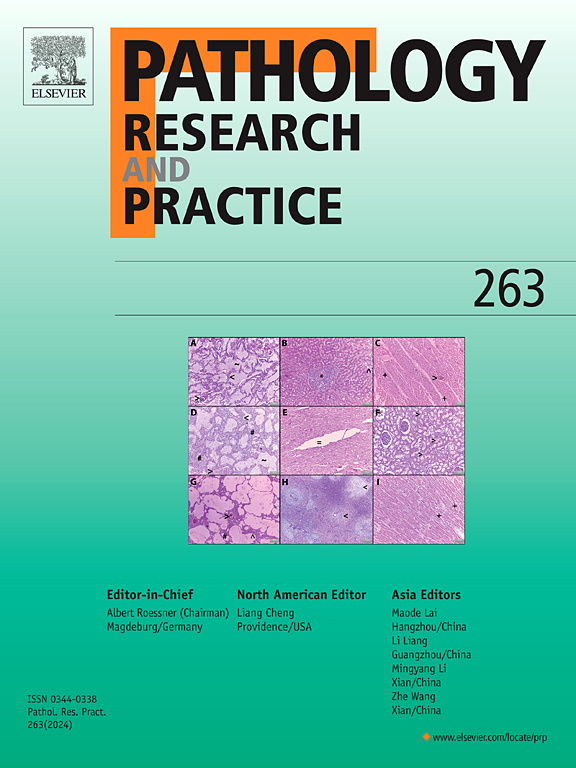Pseudomyogenic hemangioendothelioma: A series of 13 patients, highlighting unusual cardiac locations, novel gene fusions, and malignant behavior
IF 3.2
4区 医学
Q2 PATHOLOGY
引用次数: 0
Abstract
Pseudomyogenic hemangioendothelioma (PHE) is a rare vascular tumor of intermediate biologic behavior. It typically occurs in the lower extremities of young adults, and is molecularly characterized by FOSB gene rearrangements, most commonly with SERPINE1 or ACTB fusion partners. Multifocality and local recurrence are common, but distant metastasis is rare. In this retrospective study, we collected 13 cases of PHEs and described their clinicopathologic features and available molecular findings. The patients ranged from 4 to 78 years of age, and had a male predilection (male: female=3.3: 1). The tumors involved the lower extremities (n = 4), upper extremities (n = 4), trunk (n = 3), and most extraordinarily, the heart (n = 2). Most cases showed typical histologic features with eosinophilic plump spindle cells, frequent inflammatory infiltrate, and immunoreactivity to cytokeratin (9/9), ERG (8/8), CD31(5/9), FOSB (7/7), and rarely CD34 (1/6). One exceptional case showed an extensive myxoid stroma and spindle to epithelioid cytomorphology. Molecular findings were available in 4 cases, with SERPINE1::FOSB, ACTB::FOSB, MAPK1IP1L::FOSB, and NPIPA7::NIPBL fusions in one case each. The novel MAPK1IP1L::FOSB and NPIPA7::NIPBL fusions were both detected in cardiac tumors. In total, 4 patients had metastatic diseases, which affected the bones (n = 3), lungs (n = 2), skin (n = 1), brain (n = 1), and lymph nodes (n = 1). Two patients died of diseases, both with pulmonary metastasis at initial presentation. In conclusion, our cohort expands the clinicopathologic spectrum of PHE, with a wide range of age, cases with unusual cardiac locations, novel MAPK1IP1L::FOSB and NPIPA7::NIPBL fusions, and uncommon malignant behavior.
假性肌原性血管内皮瘤:13例患者,突出异常的心脏位置,新的基因融合和恶性行为。
假肌原性血管内皮瘤是一种少见的中等生物学行为的血管肿瘤。它通常发生在年轻人的下肢,并以FOSB基因重排为分子特征,最常见的是SERPINE1或ACTB融合伴侣。多灶性和局部复发是常见的,但远处转移是罕见的。在这项回顾性研究中,我们收集了13例原发性肝纤维化病例,并描述了他们的临床病理特征和现有的分子检查结果。患者年龄4 ~ 78岁,以男性为主(男:女=3.3:1)。肿瘤累及下肢(n = 4)、上肢(n = 4)、躯干(n = 3),最特别的是心脏(n = 2)。大多数病例表现出典型的组织学特征,嗜酸性饱满的梭形细胞,频繁的炎症浸润,对细胞角蛋白(9/9)、ERG(8/8)、CD31(5/9)、FOSB(7/7)有免疫反应,很少有CD34(1/6)。一个例外的病例显示广泛的黏液样间质和梭形上皮样细胞形态。4例患者均有SERPINE1::FOSB、ACTB::FOSB、MAPK1IP1L::FOSB和NPIPA7::NIPBL融合。新的MAPK1IP1L::FOSB和NPIPA7::NIPBL融合体均在心脏肿瘤中检测到。总共4病人转移性疾病,它影响了骨头(n = 3)、肺(n = 2)、皮肤(n = 1),大脑(n = 1),淋巴结(n = 1)。2例患者死于疾病,均在最初出现肺转移。总之,我们的队列扩展了PHE的临床病理谱,年龄范围广,心脏位置不寻常的病例,新型MAPK1IP1L::FOSB和NPIPA7::NIPBL融合,以及罕见的恶性行为。
本文章由计算机程序翻译,如有差异,请以英文原文为准。
求助全文
约1分钟内获得全文
求助全文
来源期刊
CiteScore
5.00
自引率
3.60%
发文量
405
审稿时长
24 days
期刊介绍:
Pathology, Research and Practice provides accessible coverage of the most recent developments across the entire field of pathology: Reviews focus on recent progress in pathology, while Comments look at interesting current problems and at hypotheses for future developments in pathology. Original Papers present novel findings on all aspects of general, anatomic and molecular pathology. Rapid Communications inform readers on preliminary findings that may be relevant for further studies and need to be communicated quickly. Teaching Cases look at new aspects or special diagnostic problems of diseases and at case reports relevant for the pathologist''s practice.

 求助内容:
求助内容: 应助结果提醒方式:
应助结果提醒方式:


